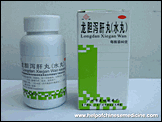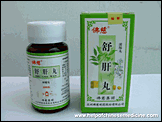Shenyi Center of Chinese medicine has a variety of Chinese medicines for liver. click here
- Chinese Medicine for cardiovascular diseases and heart
- Chinese Medicine for gastro-intestinal disorders (poor appetite, indigestion, gastritis, diarrhea)
- Chinese Medicine for men (prostatitis, impotence etc.)
- Chinese Medicine for women (gynecological conditions, pre-menstrual syndrome, infertility)
- Chinese Medicine for liver syndromes (fatty liver, hepatitis)
- Chinese Medicine skin diseases (swelling, eczema, psoriasis)
- Chinese Medicine for asthma, bronchitis, chronic coughs
- Chinese Medicine for rheumatism, arthritis, osteoarthritis
- Chinese Medicine for hypertension
- Chinese Medicine for allergies
- Chinese Medicine for common cold and flu, sore throat
- Chinese Medicine for pain relieve
- Chinese Medicine for fatigue syndrome
- Chinese Medicine for weight loss
Dosage: half cap or full bottle cap each time(3-6g), 2 times per day, bottle contains 60 g
Manufacturer: Guangzhou Huacheng
Read more...
Symptoms include abdominal distention and pain, nausea, belching, poor appetite, gas, and loose stools, fullness and distention in the chest and hypochondrium, stomachache, gastric upset and vomiting, eructation and acid regurgitation.
Dosage: 6 pills per time, 2-3 times per day, contains 200 pills
Manufacturer: Lanzhou Foci
Read more...
Herbal medicine in the treatment of liver diseases.
Stickel F, Schuppan D.
Institute of Clinical Pharmacology, University of Berne, Murtenstrasse 35, CH-3010 Berne, Switzerland.
Herbal drugs have become increasingly popular and their use is widespread. Licensing regulations and pharmacovigilance regarding herbal products are still incomplete and clearcut proof of their efficacy in liver diseases is sparse. Nevertheless, a number of herbals show promising activity including silymarin for antifibrotic treatment, phyllantus amarus in chronic hepatitis B, glycyrrhizin to treat chronic viral hepatitis, and a number of herbal combinations from China and Japan that deserve testing in appropriate studies. Apart from therapeutic properties, reports are accumulating about liver injury after the intake of herbals, including those advertised for liver diseases. Acute and/or chronic liver damage occurred after ingestion of some Chinese herbs, herbals that contain pyrrolizidine alkaloids, germander, greater celandine, kava, atractylis gummifera, callilepsis laureola, senna alkaloids, chaparral and many others. Since the evidence supporting the use of botanicals to treat chronic liver diseases is insufficient and only few of them are well standardised and free of potential serious side effects, most of these medications are not recommended outside clinical trials. Particularly with regard to the latter, adequately powered randomised-controlled clinical trials with well-selected end points are needed to assess the role of herbal therapy for liver diseases.
Investigation on the molecular mechanisms of anti-hepatocarcinoma herbs of traditional Chinese medicine by cell cycle microarray
Wang GL, Chen CB, Gao JM, Ni H, Wang TS, Chen L.
Molecular Cytogenetics Lab, Nankai University, Tianjin 300071, China.
OBJECTIVE: To design DNA microarray and investigate the molecular anti-tumor mechanism of herbs of traditional Chinese medicine. METHOD: cDNA microarrays consisting of 56 probes representing 24 human cell cycle genes were constructed, Four anti-hepatocarcinoma herbs including Radix Linderae, Hebra Artemisiae Annuae, Radix Amebiae, Radix Astragli, were chosen. Effects of herbs on SMMC-7721 cell cycle were observed by flow cytometry assay. Effects of herbs on cell cycle gene expression in SMMC-7721 cells were analyzed by comparing hybridization of Dig-Labeled cDNAs from herb-treated cells and cDNAs from untreated cells. RESULT: Expressions of cell cycle geneswere changed in different degrees after herbs treated. Some genes were down-regulated and some genes were up-regulated. The changes in gene expression agreed with the results of flow cytometry assay. CONCLUSION: The results suggest that these herbs may have effects on cell cycle and DNA damage checkpoint genes which may be the mechanism of the herbs, and DNA microarray can be used to investigate the biological function of extracts of traditional Chinese medicine.
Studies on treatment of fatty liver with traditional Chinese medicine
Xu LM, Hu YY.
Institute of Liver Diseases, Shanghai University of Traditional Chinese Medicine, Shanghai 200032, China.
Great progress has been made in the study of fatty liver with integrated traditional Chinese and western medicine in aspects of diagnosis, treatment and experimental study, etc. Most researches were designed to utilize diagnostic or model replicating method of western medicine to observe the effects or investigate the action mechanism of compound recipe, single Chinese herb or effective ingredients of Chinese herbs on fatty liver. According to the pathological mechanism of traditional Chinese medicine (TCM), fatty liver is characterized by deficiency in nature and repletion in appearance, which involves three Zang viscera such as liver, spleen and kidney and manifests as spleen Qi deficiency, liver and kidney deficiency, phlegm and dampness heaping internally, and Qi stagnation and blood stasis. This facilitates us to use specific recipe or modified recipe to treat fatty liver from the points of integrated traditional Chinese and western medicine and combining syndrome differentiation with disease differentiation. With gratifying achievement, this kind of approach has been the mainstream of the research on fatty liver and many researchers have reached an agreement on this point domestically. Spleen Fortifying and Blood Invigorating Recipe (SFBVER in brief, invented by our institute) can significantly improve the B ultrasound outcome of the liver in patients with fatty liver, with significant difference in B ultrasound scoring between pre-and post-treatment. It can alleviate the patients' symptoms, improve or regain liver function, decrease waist/buttocks ratio and the content of triglyceride and cholesterol in blood. SFBVER is superior to Dongbao Gantai Recipe in general effective rate. Experimental study also reveals that SFBVER can alleviate CCl(4) induced liver cell fatty degeneration and the inflammatory cell infiltration in rats, decrease the activities of ALT and AST, lower the content of triglyceride in liver, recover SOD activity in liver to normal level. The overall efficacy of SFBVER is superior to that of Dongbao Gantai Recipe. Further correlated study should be focused on inventing new preparation of traditional Chinese medicine and investigating its action mechanism with the guiding of the theory of TCM and referring to the latest discovery in fatty liver research in modern medicine.



